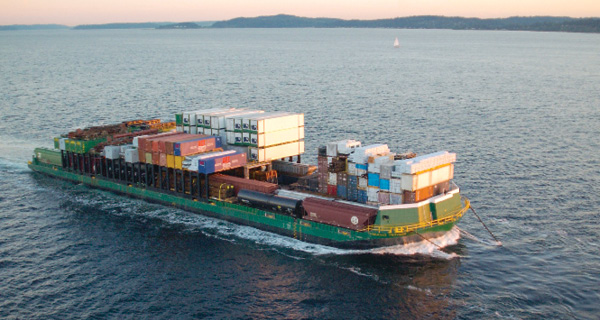
Networked Track Sensors Keep Rails and Workers Safe
The current state of rail integrity and safety is a critical issue for logistics managers who increasingly rely on intermodal transportation. Intermodal rail traffic has significantly increased during the past two decades, according to the U.S. Department of Transportation. In addition to increased rail traffic, aging infrastructure complicate intermodal shipping. In 2011, the Federal Railroad […]
Read More
Connect, Secure, and Manage the Supply Chain
Q: How are transport and logistics firms using mobility to improve employee engagement? A: Mobility once meant giving each driver a cell phone. Today, however, connected devices with communication applications allow drivers to get news and road updates, connect with family, and do business anywhere and anytime. By accessing training programs while waiting for a […]
Read More
Heading North: Navigating Alaska’s Supply Chain
The road to success in the Last Frontier is paved with logistics demands and challenges.
Read More
Protecting High-Value Cargo: A Sense of Security
When moving one-of-a-kind artwork, luxury items, and high-priced electronics, call in the cargo cops. That’s a 10-4.
Read More
Cold Storage: Optimization by Degrees
As the food industry gets a taste of rising prices, fluctuating energy costs, and new regulations, shippers develop a growing appetite for 3PLs and refrigerated public warehouses to help drive greater efficiency inside the four walls.
Read More
Shipment Monitoring Technology: Picking Up the Signals
From basic to complex, tracking devices give shippers the power to locate and secure cargo at any point in the supply chain.
Read More
Efficient and Compliant Hazmat Shipping: Today You Can Have Both
Q: What are the common hazmat violations, and what are the consequences for shippers and carriers? A: In the United States, both the Department of Transportation (DOT) and the Federal Aviation Administration (FAA) regulate hazardous material (or dangerous goods) transportation. Penalties can range from a few thousand dollars to more than one million dollars, and […]
Read More
Keys to Developing Strong Supply Chain Partnerships
Q: How can value chain partners collaborate to enhance performance and efficiencies? A: Collaboration among supply chain partners can improve supply chain performance, create new capabilities, and increase efficiencies. Meeting to review performance objectives helps build stronger partnerships based on definable measurements and greater transparency, and encourages more effective supply chain practices. Part of this […]
Read More
Untangling the Complications of Free Trade Agreements
Q: Why should companies consider trade agreements when looking to find the best sourcing option? A: Companies need to factor into their sourcing decisions the opportunities provided by free trade agreements if they are to truly reduce lead times and take advantage of cost savings available throughout their supply chain. By incorporating trade agreements into […]
Read More
Avoiding Pitfalls to TMS Implementation
Q: What can go wrong when launching a transportation management system (TMS)? A: Implementing a TMS is a proven way to reduce cost and gain control of your organization’s transportation expenses. Yet many companies implement systems only to fall short of the return on investment (ROI) they expected. Sometimes the problem stems from failure to […]
Read More
Get Real: What ROI to Expect from Your TMS Implementation
Q: Transportation management system (TMS) solution providers routinely claim their automation tools will deliver cost savings as high as 25 to 30 percent of annual transportation spend. Is this accurate? A: Sales representatives have a tendency to oversell things in their pursuit of new clients. This is problematic for the industry because it discredits TMS […]
Read More
Big Data Tools Enable Predictive and Prescriptive Analytics
Q: What is different in transportation technology today compared to five years ago? A: Two words: big data. It has become significantly less expensive in the past five years to store and analyze large amounts of data. Due to these decreased costs, companies can now afford to use data to gain additional insight into their […]
Read More
The Fundamentals of Successful Value Chain Partnerships
Q: How can value chain partners cooperate to create and share efficiencies? A: With an unprecedented global reach, access to new markets, increased regulation, and huge advances in technology, today’s supply chain environment is more complex than ever. Coupled with increasing customer demands for speed, flexibility, cost efficiency, quality, and customization, it is very difficult […]
Read More
Accessible Capital, Trustworthy Partners Key to Managing Freight Costs
Q: What is the key to managing freight spend in today’s environment? A: In addition to the slow growth economy, the transportation industry has been hit with significant economic and industry challenges, including increasing regulations, driver shortages, fluctuating fuel costs, and a tight credit environment. Carrier costs are going up—costs that will likely get passed […]
Read More
Maximizing the Benefits of Your TMS
Q: What are the best ways to get the full benefit of a transportation management system (TMS)? A: First, work with your solution provider to configure the system to meet your unique requirements and workflow, and to automate managing your transportation network. A system you can implement quickly and that meets your requirements enables you […]
Read More
The Power of Demand-Driven
The inbound logistics concept has a lot of pull in today’s marketplace—and for good reason. Consignees want control. Having visibility to product and processes at different supply chain touch points empowers you to make smart decisions about positioning and moving inventory. Companies embrace this enthusiasm for demand-driven practices in countless ways. For example, some importers […]
Read More2014 Top 100 Logistics IT Providers
Information is power. Inbound Logistics’ annual logistics IT research survey uncovers the latest trends powering the supply chain, and reveals the Top 100 sector leaders.
Read More
Leveraging Big Data
Think big – but start small – when mining big data to propel your supply chain forward.
Read More
Streamlining Inventory Through SKU Rationalization
While supply chain and logistics managers pursuing Lean operations generally seek to eliminate excess inventory, sales and marketing programs often lead companies to increase the volume of products they keep in stock. During the past few decades, the number of stockkeeping units (SKUs) retailers offer has soared. For example, in 1970, the average grocery store […]
Read More
Laying the Foundation For a Long-Term 3PL Partnership
Many companies start working with a third-party logistics (3PL) provider to fix an isolated problem at the lowest possible cost. Unfortunately, these relationships are often short-lived and serve only to fill an operational gap. But thoughtfully planned 3PL partnerships can produce invaluable results using a long-term approach that focuses on sustainable operational gains, rather than […]
Read More